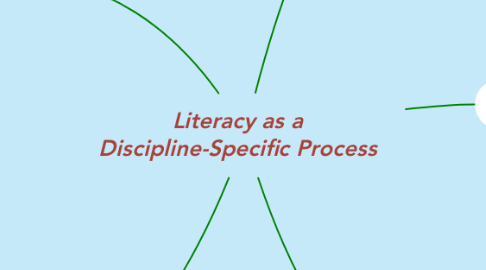
1. Academic Disciplines
1.1. A branch of learning or scholarly instruciton
1.2. Understand the role of expertise, inquiry, critical thinking skills, evidence, & validation.
1.3. Mathematics
1.3.1. Problem Solving
1.3.2. Metacognition
1.3.3. Sense making
1.3.4. Seeking a solution
1.3.5. Exploring patterns
1.3.6. Formulate conjectures
2. Why Position Literacy in the Disciplines?
2.1. Common Elements: Language, Text, Concepts, Reflections
2.1.1. Mathematical thinking: Asking questions, Identifying problems, Analyzing, Comprehending, Problem Solving
2.2. Each discipline is unique
2.3. To put knowledge to use in all disciplines
2.4. Learning on the diagonal
2.4.1. Content knowledge
2.4.2. Learning on the diagonal
2.4.3. Habits of mind
3. Content Area Literacy
3.1. Reading & Writing
3.2. Teachers must prepare
3.3. Misconceptions
3.3.1. Students know how to read and write coming into middle school level
3.3.2. Students have prior content knowledge
4. Disciplinary Literacy
4.1. 1. Basic Literacy
4.1.1. Decoding and knowledge of high frequency words
4.2. 2. Intermediate Literacy
4.2.1. Exposed to complex text, Develop fluency, vocabulary, and generic comprehension
4.3. 3. Disciplinary Literacy
4.3.1. Complex text, Acquire knowledge and processes appropriate for each discipline
4.4. Think like an expert
5. Disciplinary Literacy Learning Principles
5.1. Socially Constructed Process
5.1.1. Trust their peers and comfortable classroom environment and experience support
5.2. Teacher as a Mentor, Student as Apprentice
5.2.1. Being able to observe and participate. Apply the knowledge to real life.
5.3. Content and Literacy Knowledge develop in Tandem
5.3.1. Interact with print and non-print text. Have a deep conceptual understanding of content
5.4. Students engage in Discipline-Specific Inquiry Learning
5.4.1. Learn by doing. Create opportunities to reflect and learn, defend and elaborate, share their understandings.
5.5. Assessment to Drive Instruction, Instruction to drive assessment
5.5.1. Use multiples types of assessments, formal and informal.

